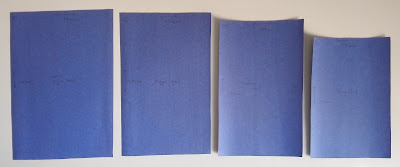REFERENCE: Harris, P. and Ambrose, G. (2007) The Layout Book. Lausanne, Switzerland: AVA Publishing.
Names refer to a) the original paper size, for example, Royal and b) the fraction an individual page occupies, for example, Octavo - 8th. The image below shows the most common book sizes and formats used within publishing.
Although the guidebook I am aiming to produce is going to be unconventional in its nature as a guidebook and more as an informational, souvenir publication, it is decided that this should still be reasonably sized in order to keep an element of the typical nature of guidebooks in that they are generally small enough to travel around with. If this publication is going to be more of a souvenir publication, this also means that potentially it could be sold at bookshops and so therefore would work better if produced at the typical size of a standard book/novel, and dainty enough to be easily slipped in and out of a book case to protect the book itself.
 |
| Right to left: Demy (16mo), Demy (18mo), Foolscap Octavo (8vo), Crown (8v0) and Large Crown (8vo). |
Based on these standard book formats, it has been considered that the most suitable sizes for this specific publication would potentially either be Demy (16mo) or Demy (18mo) since these were found to generally be the typical size of the kind of publication I am creating. However, this may change as I start to build up content within the publication itself since the size of the book needs to be able to work with the type of pictorial and textual content used.
 |
| Right to left: Demy (8vo), Medium (8vo), Royal (8vo) and Super Royal (8vo). |
 |
| Right to left: Crown (4to), Foolscap Quarto (4to) and Imperial (8vo). |
 |
| Right to left: Demy (4to) and Royal (4to). |




No comments:
Post a Comment